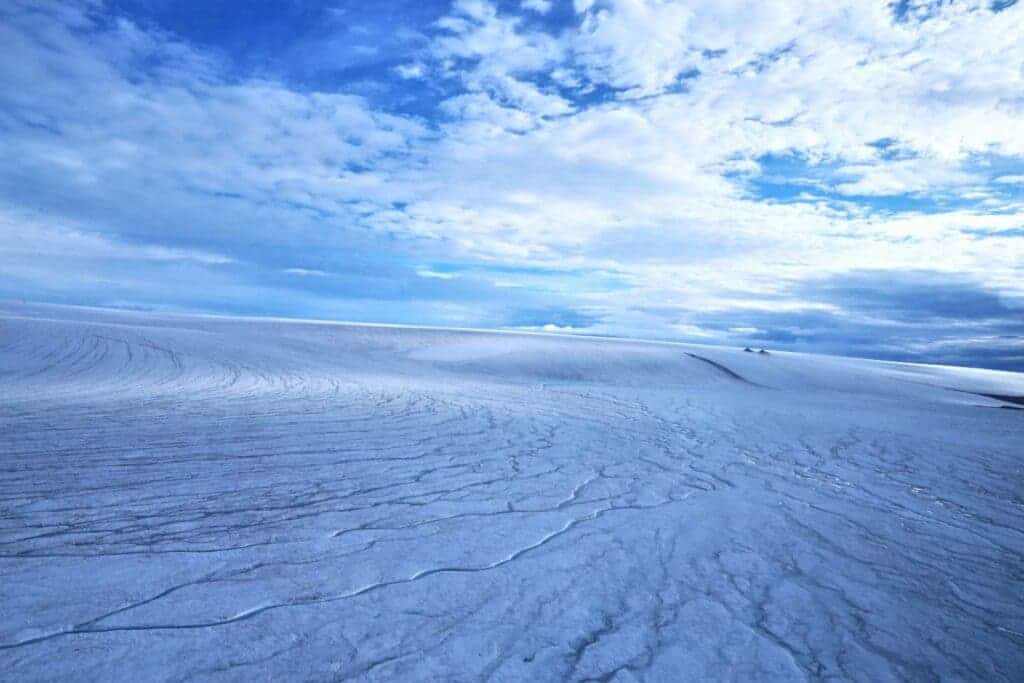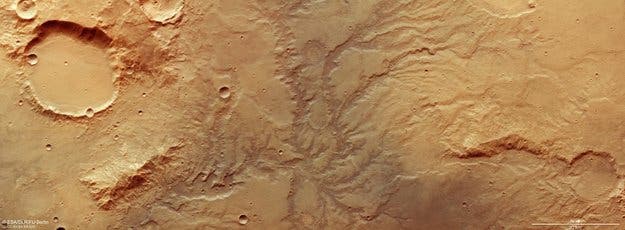
The Red Planet is littered with branching, desiccated systems of trenches and valleys that seem to have been carved by flowing water, and are likely 3.5 to 4 billion years old. A new study, however, makes the bold assertion that most of these valley networks were actually carved by water melting beneath glacial ice rather than free-flowing rivers.
Glacial Mars
In 1877, Italian astronomer Giovanni Schiaparelli first observed mysterious straight lines along the planet’s equatorial regions, which he called canali (canals). However, what he saw was merely an optical illusion produced by the lens of his telescope. But, as it turns out, there really are canali, or watercourses, on Mars. It was only much later, with the advent of high-resolution telescopes and after we sent spacecraft to Mars, that this became obvious.
The image below captured by ESA’s Mars Express satellite in 2019 is illustrative in this regard. It shows a system of valleys located in the southern highlands of Mars, east of a huge impact crater called Huygens and north of Hellas, which is the largest impact basin on the red planet. The dendritic pattern akin to tree branches or brain cells is what you’d expect to see for a world that is covered in rivers (like Earth) or that used to host such free-flowing water systems (like is believed to have been the case in early Mars).

But for Anna Grau Galofre, a former PhD student at the University of British Columbia, these channels don’t look at all like they were made by ancient Martian rivers.
She and colleagues examined thousands of Martian valleys and compared them to subglacial channels in the Canadian Arctic Archipelago, finding striking similarities.
“For the last 40 years, since Mars’s valleys were first discovered, the assumption was that rivers once flowed on Mars, eroding and originating all of these valleys,” says Grau Galofre. “But there are hundreds of valleys on Mars, and they look very different from each other. If you look at Earth from a satellite you see a lot of valleys: some of them made by rivers, some made by glaciers, some made by other processes, and each type has a distinctive shape. Mars is similar, in that valleys look very different from each other, suggesting that many processes were at play to carve them.”
The team’s work was initially inspired by subglacial channels on Devon Island in the Canadian Arctic. Devon, with its inhospitable polar climate and glaciation, is one of the best analogous of Mars here on Earth. If the two are so similar, could have many of the red planet’s geological features also been shaped by glacial processes?
Using a novel machine-learning algorithm, the researchers were able to go through 10,000 Martian valleys, looking for patterns that underlie different erosion processes. Turns out that most of the channels seem to have been carved by subglacial erosion and only a fraction of valley networks match patterns typical of surface water erosion.
“These results are the first evidence for extensive subglacial erosion driven by channelized meltwater drainage beneath an ancient ice sheet on Mars,” says co-author Mark Jellinek, who is a professor in UBC’s department of earth, ocean, and atmospheric sciences. “
These new findings topple the conventional view of Mars’ valley systems on its head. Although it might require more substantial evidence to be embraced by the scientific community, the findings also make sense in the context of early Mars.
Scientists believe that Mars’ valley systems were formed around 3.8 billion years ago — a time when the sun was less intense and Mars received less sunshine.
“Climate modelling predicts that Mars’ ancient climate was much cooler during the time of valley network formation,” says Grau Galofre, currently a SESE Exploration Post-doctoral Fellow at Arizona State University. “We tried to put everything together and bring up a hypothesis that hadn’t really been considered: that channels and valleys networks can form under ice sheets, as part of the drainage system that forms naturally under an ice sheet when there’s water accumulated at the base.”
Life may have still found a way
The new study casts doubt over the conventional view of a wet Mars, dotted with flowing river systems, encased in a thick atmosphere that may have been conducive to life.
However, this alternative scenario doesn’t lower the odds of ancient Mars supporting life. In fact, if anything, the odds were more favorable since ice sheets would have offered more protection for any life forms in the underlying water.
And even if Mars’ famous canali weren’t carved by glaciers, the analytical tools developed by the researchers are still mighty useful. The same approach can be applied to geological features here on Earth, in order to uncover hidden patterns about our planet’s early history.
“Currently we can reconstruct rigorously the history of global glaciation on Earth going back about a million to five million years,” says Jellinek. “Anna’s work will enable us to explore the advance and retreat of ice sheets back to at least 35 million years ago–to the beginnings of Antarctica, or earlier–back in time well before the age of our oldest ice cores. These are very elegant analytical tools.”






